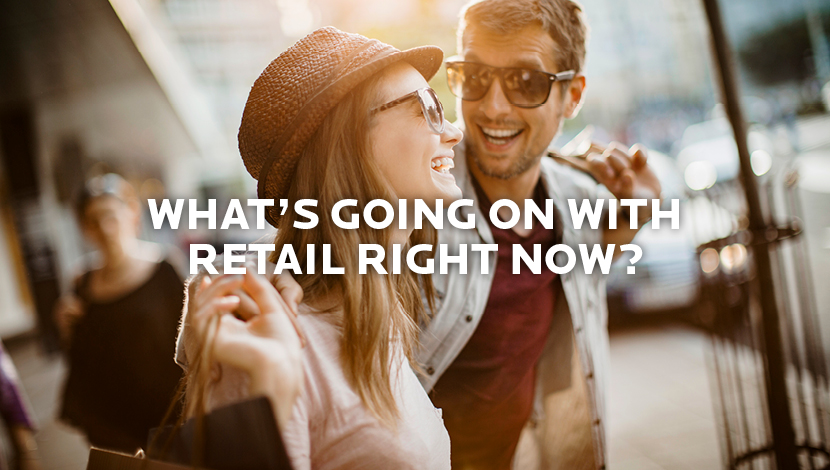
As brick and mortar retail stores close at record rates, what can retailers do to change—and thrive?
Customers are shifting their shopping and buying from brick and mortar stores for specific transactions to expectations for experiences. Experiences that speak to them, that show retailers understand what they want and need and feel. With the right strategy and intentional adaptations, retailers’ brick and mortar locations can still compete – and give buyers what they want.
Technology has undoubtedly shifted consumer buying habits. From a personal device, buyers can get quick and often free product deliveries, access research and reviews, visualize how a product would look or fit, and even get instant answers to product questions – all making it easier for consumers to easily and confidently complete transactions. As testament to this trend, Amazon Prime is now used in 64 percent of all U.S. households, and online sales have grown exponentially over the past two years.
While online experiences may seem all encompassing, one thing is missing—the tactile and sensory experience with a product or place. Engaging consumer senses can have significant persuasive impact if the sensory experience is perceived positively. And in turn, can be a powerful motivator.
Whether retailers are brick and mortar based or strictly online, the industry is experiencing rapid change. And with that, consumer expectations are changing. So what do marketers and retailers need to know to embrace these changes and create opportunities?
Consider the demographic shift
Roughly 80 million millennials will enter the U.S. marketplace in the next few years. They make up 25 percent of the U.S. population and 21 percent of the discretionary purchases. Millennials want authentic, socially responsible and useful products. And, they expect experiences. They are less focused on the transaction and more focused on the interaction – interactions in social spaces, in physical spaces and in online storefronts. Their influence has begun to shape several industries, including dining, retail and travel. While millennials are swooping in, baby boomers remain a powerful consumer class – one that is engaged in social spaces and seeks written content and videos. More on this shift from AdWeek .
Individualized experience equals big impact
This is one of the biggest shifts taking place in today’s retail landscape. Shoppers want unique merchandise and personal experiences. Avoiding mainstream and widespread trends has become the new trend. Small, local boutiques are becoming popular. They operate with less overhead, have the freedom to sell what they want without answering to corporate standards, and can tailor events and experiences to their clientele. But, even large retailers can embrace some of these concepts by individualizing experiences, organizing stores with branded or boutique areas, and engaging personally with customers.
Content is not controllable, only contributable
Gone are the days when brands and retailers controlled messaging and consumer knowledge through advertising. Today’s consumer gathers and engages with information constantly and most of that content will not be developed or published by the brand or retailer. Consumers seek authentic, clear, and unbiased third party communication and insights. Retailers can contribute strong product and brand content, but they can’t control how others respond or interface with that content. Because of this, brands must focus on being helpful, providing value or insights and answering questions. In this way, retailers and brands can build trust. People want to purchase from brands, companies and retailers they trust. And, 76 perent of millenials and baby boomers perceive user generated content (UGC) as more honest than brand advertising. More on UGC from AdWeek.
Create customer experiences
At a small Fargo boutique a customer is asked, “Would you like a glass of champagne?” Contrast that with, “Can I help you find something?” It’s customer experience verses customer transaction. The glass of champagne enhances the customer’s experience – it is sensory, tactile and leaves an impression. People tend to share things that are meaningful, memorable and emotional. Big or small, personal touches, loyalty perks and unique gestures that appeal to senses and emotions can have a significant impact.
How you can adapt to this change? To get the ideas flowing, here are some examples of retailers who are not just targeting a transaction, but creating an experience.
- Lululemon – This yoga apparel company hosts complimentary in-store yoga classes every week. Namaste anyone?
- Evereve – This women’s clothing store gives mom a break with a kids’ play area that includes animal crackers, large dressing rooms and bathrooms. Have you ever tried to fit a stroller into a dressing room? Then this store is for you.
- Scheels – From Ferris wheel rides to kids’ bowling, this sporting goods retailer brings family-friendly fun into their store. Top that with superior customer service and you bet I’d bring my entire family there any day.
- Everette’s barbershop – In addition to serving typical drink options like water or coffee, they offer their clients craft soda made by a local brewery, creating that perfectly unique experience.
- Target – They took Starbucks, a brand that has a captive audience, and placed it right inside their entrance. To improve their shoppers’ in-store experiences, Target offers coffee cup holders that hook right on their carts. A simple convenience that makes it easier to shop.
Bottom line, retail is changing. But with the right approach and willingness to adapt, brands and retailers can embrace this change and create unique, meaningful and memorable experiences that show customers they are paying attention.
For support in making this new reality your reality, connect with us – we’ll bring our retail and marketing expertise to you!
